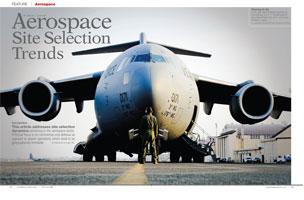
 |
| Roaring to life: Tech. Sgt. Mark Shertzer watches as the engines of a C-17 Globemaster III are started March 20, 2011 at Yokota Air Base, Japan (U.S. Air Force Photo/Staff Sgt. Jonathan Steffen) |
Introduction
This article addresses site selection dynamics pertaining to the aerospace sector. Principal focus is on commercial and defense as opposed to airport operations which tend to be geographically immobile.
Industry Definition
Aerospace involves production of aircraft, guided missiles, and space vehicles. Original Equipment Manufacturers (OEMs) typically engage in R&D, final assembly/testing, some component manufacturing, and after market service/repair.
The aerospace industry is divided into two major markets. They are:
1. Military/Defense (mostly government)
Military aircraft
Missiles
Space vehicles
2. Commercial
Commercial jets
Regional jets
General aviation (business & recreation)
Corporate jet
Turbo prop
Single engine
 Defense/military makes up 55 percent of the total market. Commercial accounts make up the remaining 45 percent.
Defense/military makes up 55 percent of the total market. Commercial accounts make up the remaining 45 percent.
Industry Size/Growth
Aerospace is roughly a $210 billion industry in the U.S. Industry revenue/profits gained momentum in 2010. Growth should be moderate over the next several years as strong commercial sales will help offset decline in defense spending.
Some 1,300 companies populate the industry. However, the top 20 producers account for more that 75 percent of industry revenue. Illustrative major players, including a few foreign companies that are significant forces in the U.S., appear below.
1. Airbus (EADS)
2. Boeing
3. Alenia North America
4. Bombardier
5. Textron
Bell Helicopter
Cessna
6. Kaman Aerospace
7. Goodrich
8. Gulfstream
9. General Dynamics
10. Embraer
11. Lockheed Martin
12. Northrop Grumman
13. GE Aviation
14. Honeywell
15. Rolls Royce
16. United Technologies
Pratt & Whitney
Sikorsky
17. Triumph Aerostructures
18. Elbit Systems
Concerning workforce there are an estimated 1.1 million people employed in the U.S. aerospace industry. This includes both the public and private sectors. While aerospace production is spread throughout the U.S. there are several major concentrations. Twelve states account for 55 percent of industry headcount. By far and away, California remains the leader. But other states are rapidly gaining ground such as Texas, North Carolina, Arizona and Georgia. Proportion of aerospace employment by the top 12 states follows.
State | Total | % U.S. |
CA | 160,200 | 14.9 |
TX | 93,700 | 8.7 |
WA | 56,600 | 5.3 |
FL | 44,100 | 4.1 |
NY | 41,300 | 3.8 |
KS | 36,300 | 3.4 |
IL | 32,400 | 3.0 |
PA | 32,100 | 3.0 |
GA | 26,500 | 2.5 |
NJ | 25,600 | 2.4 |
AZ | 23,200 | 2.2 |
OH | 20,800 | 1.9 |
 |
| Exhibit 2 |
As shown in the exhibit, most new facilities have been Tier One-Three suppliers and MRO (Maintenance/Repair/Overhaul) operations. The one major OEM is Boeing with a S.C. production site for the 737 Dreamliner. There will likely be a spate of new suppliers locating within 250 or so miles of North Charleston to supply the Boeing plant. This is a good example of spreading risk and cost throughout the supply chain (heavy concentration in state of Washington). Exhibit 2 shows a photo of the plant under construction.
Interestingly, the fast growing Brazilian aircraft company Embraer will build its first U.S. factory in Brevard County, Florida (in part capitalizing on the excess labor pool emanating from NASA downsizings). Another foreign company investing in the U.S. is EADS in Mobile, Alabama.
 |
| Exhibit 3a |
 |
| Exhibit 3b |
The new First Wave MRO in Bristow, Okla., (see photo in Exhibit 4) is partly the result of the state’s workforce training and incentives customized for aerospace. The Oklahoma Aerospace Alliance represents a wide ranging partnership that has championed the state’s aerospace industry including workforce. It also helped in creation of meaningful and unique incentives (such as grants for suppliers). These efforts are paying dividends.
Similarly, Missouri has formed collaborations to support aerospace. These include the Center for Aerospace Technologies (Missouri University in Rolla) and Aerospace Research & Education Center in St. Louis (joint venture of several universities). This nurturing environment has led to several new plants and expansions including the recent Valent Aerostructures (100 new jobs) outside St. Louis (see photo of plant under construction in Exhibit 5).
 |
| Exhibit 4 |
Other states are also becoming proactive and creative in terms of enhancing aerospace industry growth. These include Florida, Ohio, North Carolina, South Carolina and Utah. The presence of state and local efforts dedicated to aerospace also should be considered by companies when siting new facilities.
 |
| Exhibit 5 |
Location Criteria
The relative emphasis placed on individual criteria will vary by function (e.g., R&D vs. high volume parts production). Generally speaking, predominant location criteria for aerospace manufacturing are composed of the following:
1. Ample supply of qualified workers, e.g.,
NC Machine operators
Sheet metal fabricators
Welders
Machinists
Machine maintenance
Technicians
Electronics
Engineering
Quality control
Engineers/program managers
Aerospace
Electrical
Industrial
Mechanical
Programmer/analyst
 2. Moderate competitive labor demand
2. Moderate competitive labor demand
Allowing for a quick ramp-up
Protecting from future skills shortage, rising turnover and wage escalation
3. High quality workforce
4. Nonunion operating environment
5. Aerospace specific technical training programs (especially community college)
6. For some facilities presence of a graduate engineering school
7. Availability of fully-serviced sites (often 50+ acres)
8. Available, modern buildings (often 100,000+ SF and high bay)
9. Redundant utility infrastructure
 10. Frequently within four hours of a major customer
10. Frequently within four hours of a major customer
11. Ease of obtaining environmental permits include hazardous waste storage/disposal
12. Tax practices/rates that are not onerous to the enterprise (e.g., sales & property tax important for more capital intensive operations)
13. Moderate business operating costs especially labor (very important for most companies) and, secondarily, electric power and real estate
14. Meaningful incentives packages which have an impact on upfront and recurring costs (e.g., payroll rebates and sales/property tax exemptions)
What’s on the Horizon
Looking toward the future, WDGC believes that aerospace companies will gravitate to areas characterized by:
1. At least a small critical mass (i.e., industry presence)
2. Surplus labor market enhanced by technical training/education (offering certifications and degrees)
3. Adequate site/building offerings and fast track construction
4. Nonunion
5. Superior utility and transportation infrastructure
 6. Enlightened leadership investing in:
6. Enlightened leadership investing in:
Removal of entry barriers (e.g., onerous taxes/regulations)
Aerospace education/training (elementary school through college)
One of the industry’s major challenges
Due to several factors including graying workforce under enrollment in pertinent fields, and suboptimal performance in math & science
Physical infrastructure including certified sites, utility capacity and highways
Partnerships to oversee the industry’s needs
We would be remiss if two North American neighbors were not mentioned. Canada has a long history in aerospace. It has nearly 100,000 aerospace workers. Principal industry segments include regional/corporate aircraft, engines, simulators/visual simulation, helicopters and MROs. Montreal is the leading cluster with other significant concentrations in southern Ontario (Ft. Erie to Toronto), Winnipeg, Alberta and Vancouver.
Mexico has benefitted from U.S. and other multi-national companies establishing components/parts facilities both for local market and export consumption. Querétaro has emerged as a leading aerospace center. Other important cities include Sonora, Chihuahua and Monterrey. Mexico’s aerospace sector includes Honeywell, Bombardier, Goodrich, Lockheed Martin, Cessna and Bell Helicopter. Due to favorable cost, Mexico is a viable offshore location.
 Concerning offshore, aerospace companies will continue to invest where growth and market potential are strongest. Emerging economies such as China, India and Brazil will be prime targets.
Concerning offshore, aerospace companies will continue to invest where growth and market potential are strongest. Emerging economies such as China, India and Brazil will be prime targets.
There will also be some offshoring for cost containment reasons, including components and probably subassemblies. We see Mexico as a strong option for cost sensitive operations. Nearshore Western Hemisphere is often overlooked but can compete favorably with Asia. Among possibilities are Panama, El Salvador, Honduras, Brazil, Chile, Argentina, Uruguay and Columbia.
Asian “tiger economies” do offer cost advantages but companies need to be aware of infrastructure challenges, questionable labor legislation, lengthy supply chains/transportation issues and political/social risk. Eastern Europe also offers interesting possibilities including some of the more obscure countries like Slovenia, Macedonia and Croatia.
Offshoring should not have a desultory impact on domestic employment. Additionally, the industry will continue to be a net exporter.
Lastly, we see widespread opportunities throughout the U.S. for aerospace site selection. Even small to mid-size metros that properly cultivate essential resources can attract at least certain segments of the industry.
While Sunbelt and Intermountain regions will continue their strong appeal, there are superb locations in other regions as well. Many have outstanding and underutilized top quality workforces. They should not be overlooked by locationally active companies.

